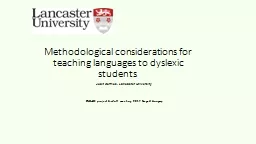

Judit Kormos Lancaster University ENGaGE project Kickoff meeting 2017 Szeged Hungary Dyslexia is like a 100 meter track race In my lane I have hurdles but no one else does and it is unfair that I am the only one with hurdles Its hard Its like starting out the gun shoots and then ID: 932256
Download Presentation The PPT/PDF document "Methodological considerations for teachi..." is the property of its rightful owner. Permission is granted to download and print the materials on this web site for personal, non-commercial use only, and to display it on your personal computer provided you do not modify the materials and that you retain all copyright notices contained in the materials. By downloading content from our website, you accept the terms of this agreement.
Slide1
Methodological considerations for teaching languages to dyslexic students
Judit Kormos, Lancaster UniversityENGaGE project Kick-off meeting 2017 Szeged Hungary
Slide2Dyslexia is like a 100 meter track race. In my lane I have hurdles but no one else does and it is unfair that I am the only one with hurdles. It’s hard. It’s like starting out, the gun shoots and then I take
off and start running like my other classmates.Because we have all had the same education how to run, I hit the first hurdle and fall flat on my face
. My parents and teachers are yelling at me at the sidelines, Try harder. The other kids are making it down the track. Okay, pulling myself up, I try running faster and fall even harder after hitting the next hurdle. Then someone takes the time to show me how to run hurdles. I can now catch up with my classmates. The key is that I have to do it differently, the way that works best for me.
Slide3RULADA
Slide4Six key elements of inclusive language teaching
Slide5What type of learning difficulties are there?
Slide6Specific learning difficulties
DyslexiaDyscalculiaDyspraxia
ADHD
Dysgraphia
Learning difficulties overlap.
Learning difficulties are placed on a continuum: there are no clear cut-off points.
Learning difficulties have different degrees of severity.
Slide7Causes of learning difficulties
Slide8Link between first and second language difficulties
SpLDs
L2 learning difficulties
Not every student with an
SpLD
will necessarily have difficulties in L2 learning.
Not everyone who is struggling to learn an L2 has an
SpLD
.
Slide9Reading difficulties in L2
Slide10Writing difficulties in L2
Slide11Difficulties with L2 listening and speaking
Slide12Difficulties with L2 vocabulary
Slide13Key elements of inclusive language teaching
Slide14Learning strategies
Discuss time-managementLearning diary/schedulePractice self-evaluationDiscuss ways about managing negative feelings and emotionsPractice use of text comprehension strategiesPractice test preparation and test taking strategies
Slide15Memory techniquesMnemonics – B
ig Elephants Can Always Understand Small ElephantsKeyword methodChunkingRhymeMind-maps
Slide16What can we accommodate?
AccommodationsClassroom management(groupwork, pairwork)
Environment (Light, temperature, seating arrangements)
Pacing
(slow down, revise, recycle)
Level of support
(teacher, peers)
Presentation and access to material
(multiple channels, handouts)
Slide17D
ifferentiateContent
Environment
Process
Product
Slide18Differentiation within tasks
Students complete only odd-numbered questions or specifically selected items Teacher provides responses to several items and the student completes the rest. Divide a worksheet into sections and student does a specific section only
Slide19Differentiation across tasks or task types
Students listen to a text instead of/while reading itStudents underline, match, select possible answers rather than writing down the answerChoice of presentation mode (e.g. spoken, written)
Slide20Multi-sensory teaching methods
Using multiple sensory channels
Slide21Components of multi-sensory teaching
Highly structured (from simple to complex)Small, cumulative stepsFrequent revision, practice
Direct, explicit teaching
Slide22More Information
www.dystefl.eu